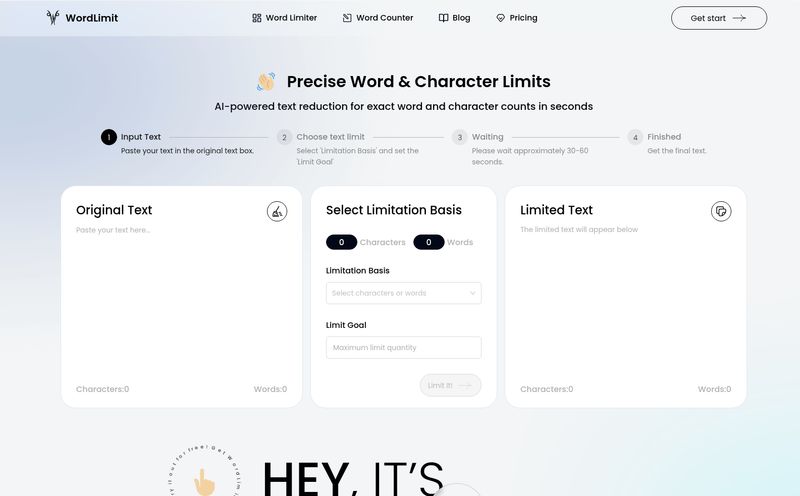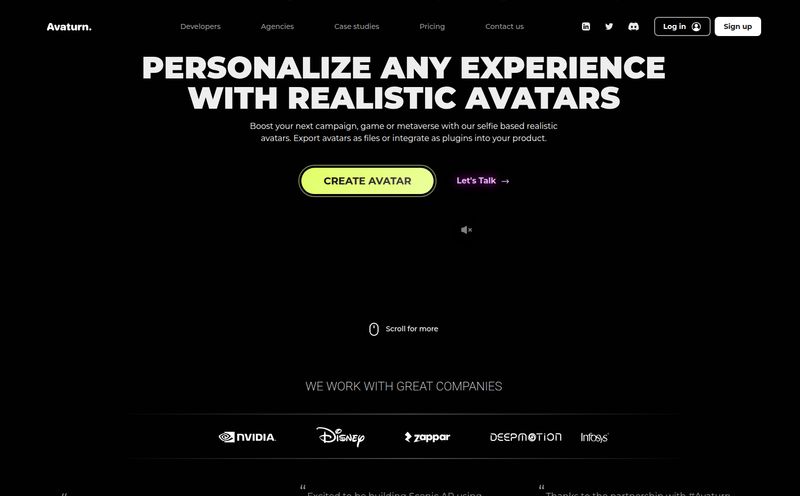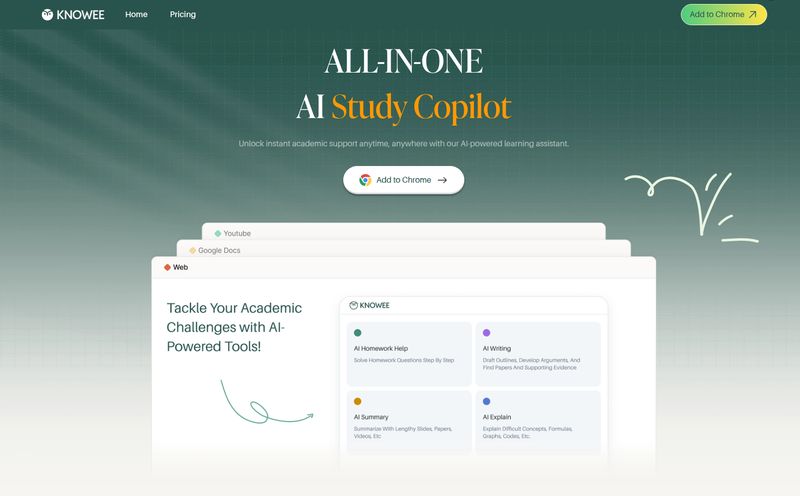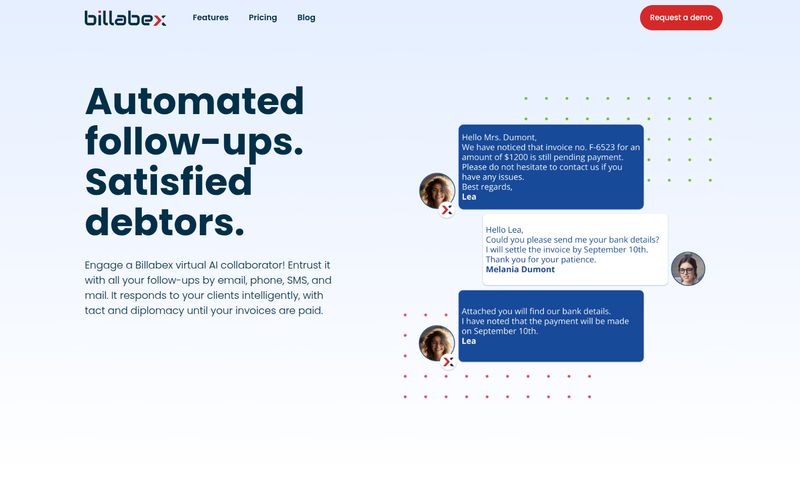We’ve all been there. You’ve got a 150-page market research report, a dense academic paper, or maybe the entire transcript of a three-hour podcast. You think, “Aha! I’ll just pop this into ChatGPT and get the highlights.” And then… you hit the wall. The dreaded context window limit. You’re left trying to feed the beast paragraph by paragraph, like a baby bird, hoping it remembers what it ate five minutes ago. It's frustrating, it’s clunky, and frankly, it’s a waste of time.
For months, I’ve been wrestling with this. It’s the single biggest headache in my content research workflow. Splitting documents, summarizing summaries… it all feels like a cheap workaround. So when I stumbled upon a tool called Long Summary, my curiosity was definitely piqued. The promise was simple, almost too good to be true: Generate custom-length summaries from texts of unlimited length. No limits. At all.
Yeah, I was skeptical too. But I had to check it out.
So What Is This Long Summary Thing Anyway?
At its core, Long Summary is exactly what it says on the tin. It’s an AI tool built for one specific, beautiful purpose: to summarize massive amounts of text. It's developed by a company called MB Skydis, who seem to have a whole suite of interesting AI products.
But here’s the kicker and the main reason we’re talking about it. Unlike the big-name LLMs like ChatGPT, Gemini, or Claude that have very real character and word counts, Long Summary claims to have no input or output size constraints. You can apparently upload a whole book and ask for a ten-page analysis, and it won’t break a sweat. This isn't just an incremental improvement; it's a completely different approach to the problem.
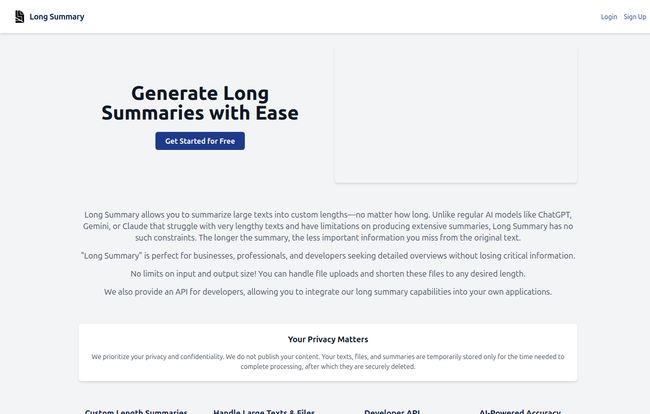
Visit Long Summary
The Real-World Pain of Text Limits
Before we go further, let's just sit with the problem for a second. The “context window wars” are a real thing in the AI space. We see headlines about Gemini 1.5’s million-token window, and it sounds amazing, but for the average user on a free or even a standard pro plan, that’s not our reality. Our reality is copy-pasting text into a box and getting an error message.
Just last week, I was trying to distill a client’s entire collection of blog posts from the last two years to find thematic gaps. It was over 100,000 words. Trying to do that with a standard AI assistant was, to put it mildly, a nightmare. The AI would forget the beginning of the text by the time it got to the end. The resulting summary was a mess of half-formed ideas. It’s like asking someone to describe a movie they only watched the last 15 minutes of.
My First Spin with Long Summary's Features
So, with that fresh pain in my mind, I took Long Summary for a spin. The interface is clean, no-nonsense. You get a box for your text or an option to upload a file. Here’s what stood out.
No More Input Limits. For Real.
I had to test this claim immediately. I took a 70,000-word public domain novel, uploaded the .txt file, and held my breath. It processed it. No errors. No “text too long” warnings. Just a quiet, whirring progress bar. The sense of relief was palpable. The ability to just drop a whole document and trust that the tool can see all of it is, without a doubt, its killer feature.
You Are the Puppet Master of Summary Length
This was the next cool thing. It’s not just about one-size-fits-all summaries. You can specify what you want. I tried a few prompts on my test novel:
- “Give me a one-paragraph summary.”
- “Provide a detailed, three-page chapter-by-chapter overview.”
- “Extract all mentions of the main character and create a character analysis.”
It handled all of them pretty well. The flexibility to go from a quick TL;DR to a genuinely detailed analysis from the same source document is incredibly powerful. It saves so much time on re-prompting and refining.
A Nod to the Devs with an API
I’m not a developer, but I know enough to be dangerous. The fact that they offer a developer API is a huge green flag. It means they’ve built this as a serious tool, not just a little web toy. I can imagine this being integrated into custom content management systems, research platforms, or internal knowledge bases. It’s a smart move that opens up a ton of possibilities.
How’s the Accuracy? A Peek Under the Hood at RAG
A big fear with summarizing long texts is that the AI will start “hallucinating” or making stuff up to fill gaps in its memory. Long Summary’s site mentions it uses RAG, which stands for Retrieval-Augmented Generation. In super simple terms, this means the AI doesn’t just rely on its general pre-trained knowledge. It actively “retrieves” information directly from your source document to construct the summary. This keeps it grounded in the facts of the text you provided, which makes for much more accurate and reliable outputs. Its not perfect, but it's a major step in the right direction for factual accuracy.
Who Should Be Using This Tool?
While I can see a lot of people using this, a few specific groups come to mind immediately.
SEOs and Content Marketers: Oh, absolutely. Think about it. You can summarize a competitor's entire content strategy, condense massive keyword research reports, or turn a 2-hour webinar into a concise blog post and a dozen social media snippets. It's a content repurposing machine.
Academics and Students: The thought of feeding a dozen dense scientific papers into this to create a literature review... it makes me wish I was still in university. This could literally save hundreds of hours of painstaking work.
Legal and Business Professionals: Wading through long contracts or financial reports is a classic time-sink. Getting a reliable summary of the key clauses and data points first could streamline the whole review process. And their claim about not publishing your data and only storing it temporarily for processing is a crucial point for this audience.
The Million-Dollar Question: What's the Price?
Okay, so here's where my investigation hit a funny snag. The site has a big, friendly "Get Started for Free" button. Naturally, my next click was to find a 'Pricing' page to see what the future costs might be. And I found... a 404 error page. Whoops.
Now, this could mean a few things. Maybe they're in a public beta phase and it's currently free while they work out the kinks. Maybe the pricing page is just temporarily down. Maybe they're planning a usage-based model. I don’t know for sure. But the fact that you can get started for free right now means there’s no harm in trying it out. It adds a bit of mystery, I suppose!
How Does Long Summary Stack Up?
A direct comparison is a little tough since it’s playing a slightly different game, but let’s give it a shot.
| Feature | Long Summary | ChatGPT (Free Version) | Claude.ai (Free Version) |
|---|---|---|---|
| Input Limit | Effectively unlimited | Limited (~3,000 words) | Generous, but still limited |
| File Uploads | Yes | No | Yes |
| Primary Function | Dedicated Summarization | General Purpose Chat | General Purpose Chat |
| Developer API | Yes | Yes (Paid) | Yes (Paid) |
As you can see, it's not trying to be ChatGPT. It's trying to do one job that ChatGPT and others struggle with, and do it exceptionally well.
Final Verdict: Is Long Summary a Keeper?
After playing around with it for a while, my answer is a resounding yes. This tool solves a specific, nagging, and widespread problem. If you are a person who ever has to digest large volumes of text for your job or studies, Long Summary feels less like a tool and more like a superpower.
Of course, it’s not magic. You should still use the summaries as a starting point and a guide, not as a replacement for critical reading, especially for important legal or academic work. But as a way to get the gist, to find the needle in the textual haystack, and to save yourself from the copy-paste-pray method? It's brilliant. It's earned a spot in my regular toolkit.
Frequently Asked Questions
- 1. Is Long Summary free to use?
- As of right now, it appears to be. There's a prominent "Get Started for Free" button on their website, but the official pricing page is currently unavailable. It's best to assume it might be a free beta or have a generous free tier.
- 2. How does Long Summary handle my data privacy?
- Their privacy policy states that they prioritize user privacy. Content, files, and summaries are not published and are stored temporarily only for the duration needed to complete the processing, after which they are securely deleted.
- 3. Can I upload files like PDFs or Word documents?
- Yes, the tool is designed to handle file uploads, which is a key part of its functionality for summarizing large documents, reports, and other lengthy files.
- 4. What is RAG and why is it important for a summarizer?
- RAG stands for Retrieval-Augmented Generation. It's a technique that allows the AI to pull information directly from the document you provide, rather than just using its general knowledge. This makes the summaries much more accurate and factually grounded in your source text.
- 5. Is the Long Summary API ready for developers to use?
- Yes, their website explicitly states they offer a Developer API for integrating their long summary capabilities into your own applications and workflows.
- 6. Who is the company behind Long Summary?
- The tool is a product of MB Skydis, a company that appears to specialize in creating various AI-powered solutions and platforms.
Conclusion
In a world of AI hype, it's refreshing to find a tool that doesn’t try to do everything. Instead, Long Summary focuses on one massive pain point—the frustrating limits of text summarization—and knocks it out of the park. It’s a simple solution to a complex problem, and for anyone drowning in text, it's the life raft you’ve been looking for.
Reference and Sources
- Long Summary Official Website
- MB Skydis Company Website
- What Is Retrieval-Augmented Generation? - An explanation from NVIDIA's blog.
